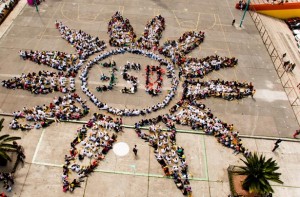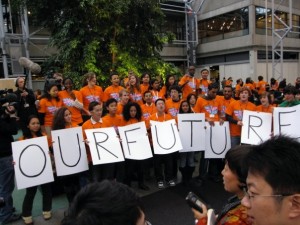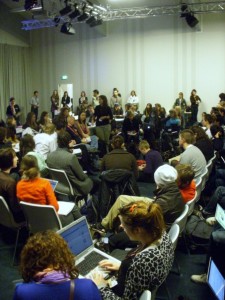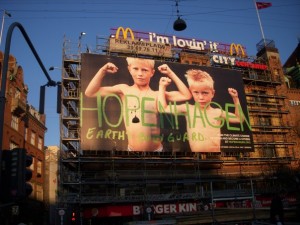Coming out of Copenhagen I was overwhelmed. I am still overwhelmed. Climate change is so much more complicated than I could have ever imagined. This is an issue of population, energy use, consumerism, economics, faith, culture, politics, science, and so much more. I cannot fathom the best method for connecting all of these pieces or which piece deserves the most immediate attention and action.
However, being a 19 year old, there was one thing that crystal clear to me after Copenhagen: whatever solution comes out of the next few COPs, my generation be the one who will have to live with it; we will be the one who will feel the effects of climate change.
There were over 2,000 youth at this conference, 500 being from the United States. The youth worked with the Least Developed Countries (LDCs), uniting over the fact that we will feel the effects of climate change the most. We worked to urge governmental delegates to recognize the need for strong and immediate action. If anything, our presence there reminded the politicians of the faces who will be affected by their decisions and how much the youth care about the world we are going to live in.
On most mornings, I would wake up early to go to the YOUNGOs meeting. They were high in energy and very organized and efficient. At YOUNGO meetings, each group would send a representative of their delegation to sit in a circle in the center of the room. Everyone else watched from the outside. The center circle made decisions on talking points so that all the youth could send a stronger, more unified message. By working with the LDCs, we were able to have our message heard by the negotiators at the plenaries as well. Once consensus was reached, the youth would all put their hands up and wave; this was a sign of agreement. I was amazed to see how quickly the youth from all different places in the world could reach consensus.
In contrast, the negotiations held in the plenary by governmental delegates rarely seemed to be making any progress. Everyone came to the plenary with their own agenda and seemed very wary of compromising their own priorities for the greater good. I remember feeling frustrated towards the end of the conference when it became more and more apparent that a binding treaty was unlikely to be made. When did the youth ever give permission to the governmental delegates to make a decision about our future? Who thought this negotiating process was a good idea? Why isn’t there a youth voice present at the negotiating table?
As much as I felt frustrated at times by the lack of control I had over the future for my generation and those to come, I couldn’t help but feel inspired by all of the amazing youth I met from all over the world. I made friends from China, France and Nigeria.
The youth were energetic, organized and able to reach consensus daily despite cultural differences. I remember standing out- side the youth briefing session, waiting to get in, chanting “I said, ohhhh, its hot in here! There must be some C-O-2 in the at-mos-phere.” Many delegates slowed down to smile at all of us chanting and one gave me a high-five : ). I couldn’t help but feel like our large presence there had to have had some sort of impact on the people making the decisions, even if it was just to remind them of their own children who will feel the effects of climate change. I am curious to see how the YOUNGOs role in the negotiations will evolve and what kind of impact they will be able to have in the COPs to come. It seems only ethical to let the youth have a bigger stake in the negotiations.
Tags: climate change, coalitions, developing countries, Dickinson College, Grace Lange, Kyoto to Copenhagen, Public Policy, student-citizens
 There has been much written on the failure of the COP15 last December. While it is true that the much-needed legally binding treaty did not happen, there were a number of positive outcomes. Before going to Copenhagen we were well aware that a legally binding commitment from major emitters was unlikely to happen, so we were prepared for such an outcome. I was guardedly optimistic about other possible outcomes, such as greenhouse gas emission reduction commitments from the U.S., an increased participation on the part of non-Annex I major emitters such as Brazil, China, and Indonesia, as well as some provisions on REDD: this was the first time that conservation was seriously considered at the international level.
There has been much written on the failure of the COP15 last December. While it is true that the much-needed legally binding treaty did not happen, there were a number of positive outcomes. Before going to Copenhagen we were well aware that a legally binding commitment from major emitters was unlikely to happen, so we were prepared for such an outcome. I was guardedly optimistic about other possible outcomes, such as greenhouse gas emission reduction commitments from the U.S., an increased participation on the part of non-Annex I major emitters such as Brazil, China, and Indonesia, as well as some provisions on REDD: this was the first time that conservation was seriously considered at the international level.
My hopes that COP15 would result in tangible action from major emitters were dampened from the first week we were there. Already, the negotiations seemed stalled, with no real accords being reached. The second week was full of tension and chaos, as heads of state began arriving in Copenhagen. As NGOs were being limited, our group was only allowed into the Bella Center until Wednesday, with restrictions on how many of us could be inside at any given time. There was much uncertainty as to whether something could be pulled together at the last minute. Personally, I did not fully digest what had happened at the COP15 until after I had gotten home and read up on different perspectives.
The Copenhagen Accord has been accused of being weak on emission targets and vague in its wording. Indeed, reading the document itself, one gets the sense that it is very open-ended and needs some more work. However, by January 31st, 2010 most countries had sent in their emission reduction targets. It is projected that about 85% of global emissions are or will be accounted for in this document. The transparency of this document is an important first step in negotiating further emission reductions. The Australian government, for example, has stated that it will improve its goal of a 5% reduction by 2020 if other countries step up and make stronger commitments. In a favorable scenario, this type of negotiation could quickly escalate countries’ emission reduction targets.
The Copenhagen Accord aside, there were some tangible positive outcomes from the latest Conference of the Parties. There were 119 heads of state present, an unprecedented number in any kind of international negotiation. This development signals an increasing involvement on part of governments everywhere, it shows unity in concern over the issue of climate change. Another important development was the exceptional youth presence. Several negotiation veterans, including our own professor, Neil Leary, said that this was the biggest youth presence they had ever seen at a COP. This youth presence indicates a growing concern among young people over their future, and a desire and commitment towards an international movement to combat climate change that will not end with the UN negotiations.
With this in mind, I now look forward to the COP16 which will take place in Cancun, Mexico from November 29 to December 10, 2010. My hopes for this year’s round of negotiations are the consolidation of a REDD + program, an increased youth presence and strengthened youth voice, more ambitious emission reduction goal commitments from major emitters, as well as an expansion of the adaptation fund. A key element to strengthening commitments is a comprehensive and ambitious reduction plan from the U.S. and that is pending on our domestic policy-makers. Now, more than ever, is the time to demand strong climate legislation in the U.S. if we are to achieve substantial progress at the COP16 this year.
Some statistics on the Copenhagen Accord:
http://www.usclimatenetwork.org/policy/copenhagen-accord-commitments
I still remember visiting the United Nations building a few years ago. Only seeing the empty conference rooms amazed me so much, and I thought it was so surreal because I have only seen them on TV before. Of course, I would have never thought of myself being able to be physically at a United Nations conference at that time. Surprisingly, I was in Copenhagen last December and I was at the UN Climate Change Conference. Even though it has already been half a year, I still feel the experience was so surreal when I look back now. I would have never imagined myself being surrounded by delegates, top scientists, medias, and youths from all around the world. The Bella Center felt just like a magnet that attracted all the important people in the world to Copenhagen. The days we spent at the conference center were so busy that we would not even find time to eat. There was so much going on in the conference center and so much to take in every minute while we were there. The rapid pace just made people forget about everything else. When I think about the experience, “amazing” would be the first word to come up in my mind, but I doubt I would use the same word to describe the result of the conference.
Before the conference, there were some parties who have already expressed their stances on the issue. European Union was willing to reduce 20 percent of greenhouse gas emissions based on the 1990 emissions level; Obama strongly supported the green economy by making billions of dollars of investment on renewable energies; and China has made a voluntary reduction target of reducing energy intensity by 40 to 45 percent by 2020 for the first time. Thus, everybody had extremely high hope for the conference and people wish there would be a meaningful agreement for the post 2012 period as the product of the conference. The goal of this conference was to solve the questions such as how much emissions the developed countries should reduce, how rapidly growing countries like China and India should control their greenhouse gas emissions, and how to fund developing countries in emissions reduction and adaptation programs. With resulting only in the Copenhagen Accord, I think the conference has somewhat let the world down.
The Copenhagen Conference was not necessarily a total failure, but it was not a complete success. First, even though the accord has set basic time and reduction framework and the developed countries agreed to reduce their emissions by 80 percent by 2050, it failed to carry out a detailed number target for each country. And even though developed countries have promised to provide developing countries with billions of dollars to help tackle the climate change issue, it did not address how the money should be allocated. Moreover, different parties, including developed and developing countries and international organizations wished the outcome of the conference could be legally binding, but it just did not happen eventually. Also, the accord did not change the goal of controlling the temperature change within 2 degrees Celsius to 1.5 degrees Celsius like many small and island countries were trying to appeal, and it did not include any specific plans, procedures, and institutions in terms of how to achieve the goal.
The conference did not completely fail simply because it could not. However, look at the bright side, this conference will guide and become the foundation of future climate change negotiations. It has set out a clear direction and recognized the areas that it needs to work on. I think all of these will be useful during the COP16 in Mexico this year. Even though Copenhagen is a place for fairy tales, I guess climate change negotiation did not have too luck to reach the ideal state.
This is the first time for me to take an interdisciplinary class and it allowed and taught me to look at things from different perspectives. The experience of this class and the trip to Copenhagen enabled me to better work with other people and to think critically. It was really sad and disheartening to learn about that people were forced to leave their homes because they were facing huge threats resulted from climate change. They were simply asking for help to keep their homeland and have a place as a home, which probably is a common commodity for people from rich countries. Seeing how grandiose and huge exhibit rooms of European Union and US were and how some countries were underrepresented made me think about the inequality and the equity issues existed during the climate change negotiations. Also at the same time, I noticed that there were so many youths there and some of them were official delegates. Active participation by the youth and the growing number of youth at the COP compared with previous years gave me hope. What I saw and learned was precious.
There is simply so much to say about this amazing experience that I probably cannot articulate myself well. I am glad that I chose to apply for the program. This is definitely the experience that I will remember for the rest of my life, and I am sure what I got out of this class will serve me well in the future. Climate change problem is the one that not only should be discussed on the international policy level, but it also must be recognized by the people on the ground. People should start taking actions simply by changing their life styles. It can be as small as taking minimum showers and recycling. It may not sound very influential, but imagine if every single person did so, how big an impact it would generate. I have been reading the news recently that thousands of miles away back on my homeland, people in south west China have been suffering from an extremely horrible drought and the land even cracked. Another city in China just got hit by a terrible earthquake that millions of people have lost their lives. The news shocked me. It was disheartening that I cannot even verbalize my feelings. Climate change did not necessarily cause these disasters, but it somewhat contributed to them. I genuinely hope that there would soon be an international climate change treaty being established and the world could see obvious progress in the process of tackling the climate change.
The division between academia and policy implementation, in the field of climate change, has in my opinion never been wider.
When I began this course, I was passionate about the study and implementation of public policy. Although I knew very little about climate change, I had studied the policy making process in both the United States Congress and the United Nations Security Council.
On the whole, public policy is a field that in theory should aim to address the needs of the global commons. With this theoretical goal, the common question that arises soon afterwards is how do policy makers go about assessing and addressing the needs of the global commons?
This is where academia can assist. Recently, I attended the Pennsylvania State University Rock Ethics Institute’s conference on “Integrating Development and Climate Change Ethics.” Along with a team of five other students, I co-authored a paper that explored climate change ethics and policy from a student perspective. Within this paper, I wrote a section about how to create public policies that address the practical and ethical concerns of the global commons.
Going into this conference, I was excited about presenting my research and interacting with other scholars in the field about the research they have done and how they have & are applying it. My hopes for the conference were instead shattered. Although I had the opportunity to share my research and receive some excellent feedback, I found that many of the presenters struggled with the notion of how to apply their research.
From inside of an air-conditioned hotel conference center, it is easy to present one’s research to their academic peers but it is not so easy to apply ones research to the policy-making process. In my opinion, the purpose of academics is to research societal occurrences, issues and complexities, with the purpose of disseminating ones’ findings to the global commons. Because policy makers aim to create legislation that is in the best interest of their constituents, academics is a great way of ascertaining what problems plague society.
In regards to climate change, academia is crucial in ascertaining the current and future affects of climate change. In theory, this information should provide policy makers with the information that they need to develop legislation. Unfortunately, this often does not happen.
On one hand, policy-makers are bombarded with practical barriers such as trying to negotiate fair legislation between over 190 parties to the United Nations Framework Convention on Climate Change. On the other hand, many academics are doing research but not actively seeking venues to present their research. Furthermore, when given the opportunity to present their research many of them are unable to persuasively articulate their ideas in a manner that warrants immediate action.
At both the United Nations Conference on Climate Change and the Rock Ethics Institute Conference on “Integrating Development and Climate Change Ethics,” I found myself frustrated by the lack of collaboration between academia and public policy. Instead of merely complaining, I began to think of ways that this gap could be closed. While in Copenhagen, I wrote all of my congress members about the severity of climate change in hopes that they will realize that immediate policy action needs to be taken.
In addition to this small action, I have decided to pursue a Master of Public Administration program at the University of Southern California. After completing my Master’s degree, I hope to either work in the policy field making decisions based on the academic findings or pursue a career in academia (that would require me to pursue a PhD in Public Policy) so that I can do research and apply it to the policy-making process. On the whole, it is my hope to merge these two fields together into the development of public policies that ethically and practically address the needs of the global commons.
Tags: Academia, Public Policy



Your Comments